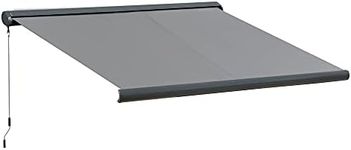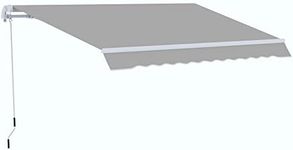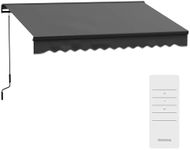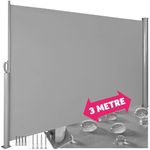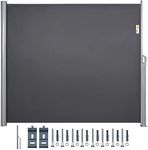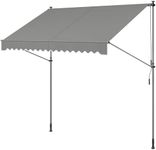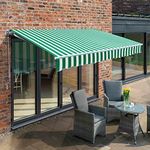Buying Guide for the Best Retractable Awnings
Choosing the right retractable awning can significantly enhance your outdoor living space, providing shade and protection from the elements. To make an informed decision, it's important to understand the key specifications and how they align with your needs. Here are the main factors to consider when selecting a retractable awning.SizeThe size of the awning is crucial as it determines the amount of coverage you will get. Measure the area you want to cover and consider the width and projection (how far it extends from the wall). Small awnings (up to 10 feet wide) are suitable for windows and small patios, medium awnings (10-20 feet wide) are great for larger patios and decks, while large awnings (over 20 feet wide) are ideal for expansive outdoor spaces. Choose a size that provides adequate shade and fits well with your outdoor area.
MaterialThe material of the awning affects its durability, appearance, and maintenance. Common materials include acrylic, polyester, and vinyl. Acrylic is known for its durability and resistance to fading, making it ideal for long-term use. Polyester is lightweight and affordable but may not last as long. Vinyl is waterproof and easy to clean, suitable for areas with heavy rainfall. Consider the climate in your area and how much maintenance you are willing to do when selecting the material.
FrameThe frame supports the awning and affects its stability and longevity. Frames are typically made from aluminum, steel, or wood. Aluminum frames are lightweight, rust-resistant, and low-maintenance, making them a popular choice. Steel frames are strong and durable but can be prone to rust if not properly treated. Wooden frames offer a natural look but require more maintenance to prevent weather damage. Choose a frame material that balances durability with the aesthetic you desire.
Operation MechanismRetractable awnings can be operated manually or with a motor. Manual awnings use a hand crank to extend and retract, which is cost-effective and reliable but requires physical effort. Motorized awnings use an electric motor and can be operated with a remote control or switch, offering convenience and ease of use. Some motorized models even come with sensors that automatically retract the awning in high winds. Consider your preference for convenience and your ability to manually operate the awning when making your choice.
UV ProtectionUV protection is important to shield you and your furniture from harmful sun rays. Look for awnings with a high Ultraviolet Protection Factor (UPF) rating. A UPF rating of 30-49 offers good protection, while a rating of 50+ provides excellent protection. If you spend a lot of time outdoors or have sensitive skin, opt for an awning with a higher UPF rating to ensure maximum protection.
Wind ResistanceWind resistance indicates how well the awning can withstand strong winds. This is particularly important if you live in a windy area. Awnings are rated by wind class, with Class 1 being suitable for light winds (up to 12 mph), Class 2 for moderate winds (up to 24 mph), and Class 3 for strong winds (up to 38 mph). Choose an awning with a wind resistance rating that matches the typical wind conditions in your area to ensure it remains stable and secure.
InstallationInstallation can vary in complexity depending on the awning. Some models are designed for DIY installation with clear instructions and minimal tools required, while others may need professional installation. Consider your comfort level with DIY projects and whether you have the necessary tools and skills. If not, factor in the cost and availability of professional installation services when making your decision.
